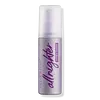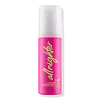What's inside
What's inside
 Key Ingredients
Key Ingredients

 Benefits
Benefits

 Concerns
Concerns

 Ingredients Side-by-side
Ingredients Side-by-side

Water
Skin ConditioningAlcohol Denat.
AntimicrobialPPG-3 Benzyl Ether Myristate
EmollientPvp
Emulsion StabilisingGlycerin
HumectantXylitol
HumectantDimethicone PEG-7 Phosphate
CleansingPhenyl Trimethicone
Skin ConditioningPolyhydroxystearic Acid
EmulsifyingDipropylene Glycol
HumectantGlycereth-5 Lactate
EmollientIsononyl Isononanoate
EmollientEthylhexyl Isononanoate
EmollientCaprylyl Glycol
EmollientSodium Cocamidopropyl Pg-Dimonium Chloride Phosphate
CleansingPhenylpropanol
MaskingSodium Hydroxide
BufferingMethyl Diisopropyl Propionamide
MaskingPropanediol
SolventAgave Tequilana Leaf Extract
AstringentParfum
MaskingAloe Barbadensis Leaf Juice Powder
Skin ConditioningMaltodextrin
AbsorbentPoloxamer 407
EmulsifyingPhenoxyethanol
PreservativePentaerythrityl Tetra-Di-T-Butyl Hydroxyhydrocinnamate
AntioxidantSodium Hyaluronate
HumectantTocopherol
AntioxidantPotassium Sorbate
PreservativeSodium Benzoate
MaskingWater, Alcohol Denat., PPG-3 Benzyl Ether Myristate, Pvp, Glycerin, Xylitol, Dimethicone PEG-7 Phosphate, Phenyl Trimethicone, Polyhydroxystearic Acid, Dipropylene Glycol, Glycereth-5 Lactate, Isononyl Isononanoate, Ethylhexyl Isononanoate, Caprylyl Glycol, Sodium Cocamidopropyl Pg-Dimonium Chloride Phosphate, Phenylpropanol, Sodium Hydroxide, Methyl Diisopropyl Propionamide, Propanediol, Agave Tequilana Leaf Extract, Parfum, Aloe Barbadensis Leaf Juice Powder, Maltodextrin, Poloxamer 407, Phenoxyethanol, Pentaerythrityl Tetra-Di-T-Butyl Hydroxyhydrocinnamate, Sodium Hyaluronate, Tocopherol, Potassium Sorbate, Sodium Benzoate
Water
Skin ConditioningAlcohol Denat.
AntimicrobialGlycerin
HumectantPvp
Emulsion StabilisingAmp-Acrylates/Allyl Methacrylate Copolymer
Phenoxyethanol
PreservativeDiisopropyl Adipate
EmollientEthylhexyl Palmitate
EmollientChlorphenesin
AntimicrobialTriethanolamine
BufferingParfum
MaskingTrihydroxystearin
Skin ConditioningCitrullus Lanatus Fruit Extract
Skin ConditioningSodium Hyaluronate
HumectantGlucomannan
Skin ConditioningIngredients Explained
These ingredients are found in both products.
Ingredients higher up in an ingredient list are typically present in a larger amount.
Alcohol Denat. is an alcohol with a denaturant property. It is created by mixing ethanol with other additives.
This ingredient gets a bad rep because it is irritating and drying - mostly due to its astringent property. Astringents draw out natural oils in tissue, constricting pores and leaving your skin dried out.
However, alcohol denat. is not all that bad.
Due to its low molecular weight, alcohol denat. tends to evaporate quickly. One study on pig skin found half of applied alcohol evaporated in 10 seconds and less than 3% stayed on skin.
This also helps other ingredients become better absorbed upon application.
Studies are conflicted about whether this ingredient causes skin dehydration. One study from 2005 found adding emollients to propanol-based sanitizer decreased skin dryness and irritation. Another study found irritation only occurs if your skin is already damaged.
Small amounts of alcohol are generally tolerated by oily skin or people who live in humid environments.
The rule of thumb is if this alcohol is near the end of an ingredients list, it will probably not affect your skin much.
Also...
This ingredient has antimicrobial and solvent properties.
The antimicrobial property helps preserve products and increase their shelf life. As a solvent, it helps dissolve other ingredients.
Other types of astringent alcohols include:
Learn more about Alcohol Denat.Glycerin is already naturally found in your skin. It helps moisturize and protect your skin.
A study from 2016 found glycerin to be more effective as a humectant than AHAs and hyaluronic acid.
As a humectant, it helps the skin stay hydrated by pulling moisture to your skin. The low molecular weight of glycerin allows it to pull moisture into the deeper layers of your skin.
Hydrated skin improves your skin barrier; Your skin barrier helps protect against irritants and bacteria.
Glycerin has also been found to have antimicrobial and antiviral properties. Due to these properties, glycerin is often used in wound and burn treatments.
In cosmetics, glycerin is usually derived from plants such as soybean or palm. However, it can also be sourced from animals, such as tallow or animal fat.
This ingredient is organic, colorless, odorless, and non-toxic.
Glycerin is the name for this ingredient in American English. British English uses Glycerol/Glycerine.
Learn more about GlycerinParfum is a catch-all term for an ingredient or more that is used to give a scent to products.
Also called "fragrance", this ingredient can be a blend of hundreds of chemicals or plant oils. This means every product with "fragrance" or "parfum" in the ingredients list is a different mixture.
For instance, Habanolide is a proprietary trade name for a specific aroma chemical. When used as a fragrance ingredient in cosmetics, most aroma chemicals fall under the broad labeling category of “FRAGRANCE” or “PARFUM” according to EU and US regulations.
The term 'parfum' or 'fragrance' is not regulated in many countries. In many cases, it is up to the brand to define this term.
For instance, many brands choose to label themselves as "fragrance-free" because they are not using synthetic fragrances. However, their products may still contain ingredients such as essential oils that are considered a fragrance by INCI standards.
One example is Calendula flower extract. Calendula is an essential oil that still imparts a scent or 'fragrance'.
Depending on the blend, the ingredients in the mixture can cause allergies and sensitivities on the skin. Some ingredients that are known EU allergens include linalool and citronellol.
Parfum can also be used to mask or cover an unpleasant scent.
The bottom line is: not all fragrances/parfum/ingredients are created equally. If you are worried about fragrances, we recommend taking a closer look at an ingredient. And of course, we always recommend speaking with a professional.
Learn more about ParfumPhenoxyethanol is a preservative that has germicide, antimicrobial, and aromatic properties. Studies show that phenoxyethanol can prevent microbial growth. By itself, it has a scent that is similar to that of a rose.
It's often used in formulations along with Caprylyl Glycol to preserve the shelf life of products.
Pvp is a water-soluble synthetic polymer and common hairstyling ingredient. It is a film-forming ingredient and used to "hold" specific shapes of hair.
Pvp is less effective in high-humidity. It tends to draw moisture, but this moisture dismantles the structure and "hold".
Sodium Hyaluronate is hyaluronic acid's salt form. It is commonly derived from the sodium salt of hyaluronic acid.
Like hyaluronic acid, it is great at holding water and acts as a humectant. This makes it a great skin hydrating ingredient.
Sodium Hyaluronate is naturally occurring in our bodies and is mostly found in eye fluid and joints.
These are some other common types of Hyaluronic Acid:
Learn more about Sodium HyaluronateWater. It's the most common cosmetic ingredient of all. You'll usually see it at the top of ingredient lists, meaning that it makes up the largest part of the product.
So why is it so popular? Water most often acts as a solvent - this means that it helps dissolve other ingredients into the formulation.
You'll also recognize water as that liquid we all need to stay alive. If you see this, drink a glass of water. Stay hydrated!
Learn more about Water